Danish Culture Canon
The Danish Culture Canon (Danish: Kulturkanonen) consists of 108 works of cultural excellence in eight categories: architecture, visual arts, design and crafts, film, literature, music, performing arts, and children's culture. An initiative of Brian Mikkelsen in 2004, it was developed by a series of committees under the auspices of the Danish Ministry of Culture in 2006–2007 as "a collection and presentation of the greatest, most important works of Denmark's cultural heritage." Each category contains 12 works although music contains 12 works of score music and 12 of popular music and the literature section's 12th item is an anthology of 24 works.[1][2]
Architecture
The committee for architecture was asked to choose 12 works covering both buildings and landscaping. It was decided that works could either be in Denmark designed by one or more Danes or abroad designed by Danish architects. The committee consisted of: Lone Wiggers (chair), Carsten Juel-Christiansen, Malene Hauxner, Lars Juel Thiis and Kent Martinussen.[3]
| Building | Location | Year | Architect | Image |
|---|---|---|---|---|
| Hover Church | near Ringkøbing, Jutland | 12th century | Unknown |  |
| Glorup Manor | near Nyborg, Funen | 12th century rebuilt 1742–1743 1762–1765 and 1773–1775 | Philip de Lange, Christian Joseph Zuber and Nicolas-Henri Jardin |  |
| Frederiksstaden | Copenhagen | 1749–1771 | Nicolai Eigtved | 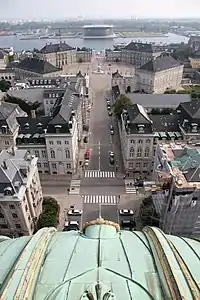 |
| Church of Our Lady | Copenhagen | 1811–1829 | C.F. Hansen |  |
| Dyrehaven | Klampenborg, Zealand | 1846 | Rudolph Rothe |  |
| Lægeforeningens boliger—Brumleby | Østerbro, Copenhagen | 1854–1856 | Michael Gottlieb Bindesbøll and Vilhelm Klein | 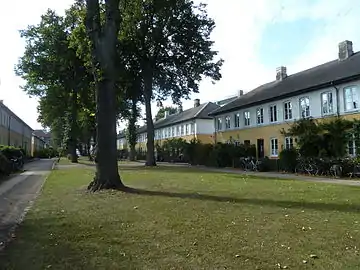 |
| Mariebjerg Cemetery | Gentofte, Zealand | 1925–1935 | G.N. Brandt |  |
| Aarhus Universitet | Århus | 1931 | Kay Fisker, C.F. Møller, Povl Stegmann and C.Th. Sørensen |  |
| Aarhus City Hall | Århus | 1937–1942 | Arne Jacobsen and Erik Møller |  |
| Finger Plan | Copenhagen | 1947 | Peter Bredsdorff |  |
| Sydney Opera House | Sydney | 1957–1973 | Jørn Utzon |  |
| Great Belt East Bridge | Zealand and Funen | 1991–1998 | Dissing+Weitling |  |
Visual arts
The committee for visual arts decided that only works of artists who had completed their oeuvre could be included. They also decided that members of the committee could each select a work they especially appreciated. In this way the committee first selected seven works whereafter five members selected one work each. The committee consisted of Hein Heinsen (chair), Hans Edvard Nørregård-Nielsen, Bente Scavenius, Bjørn Nørgaard and Sophia Kalkau.[4]
| Work | Location | Year | Artist | Image |
|---|---|---|---|---|
| Sun chariot | National Museum of Denmark | c. 1300 BC | Unknown |  |
| The Resurrection | Undløse Church | c. 1440 | Union Master |  |
| Bordesholm Altar | Schleswig Cathedral | Completed 1521 | Hans Brüggemann |  |
| Frederik V on Horseback | Amalienborg | Completed 1771 | Jacques Saly | 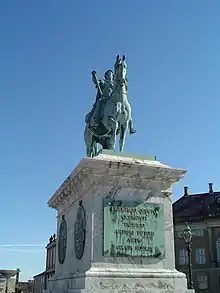 |
| Jason with the Golden Fleece | Thorvaldsens Museum | Completed 1828 | Bertel Thorvaldsen | 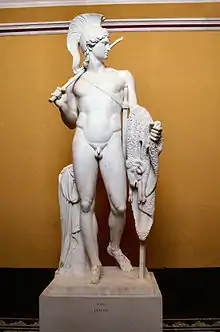 |
| A View through Three of the North-Western Arches of the Third Storey of the Coliseum | Statens Museum for Kunst | 1813–1816 | C.W. Eckersberg | |
| Autumn Morning on Lake Sortedam | Ny Carlsberg Glyptotek | 1838 | Christen Købke |  |
| Dust Motes Dancing in Sunbeams | Ordrupgaard | 1900 | Vilhelm Hammershøi |  |
| Summer Day by Roskilde Fjord | Randers Kunstmuseum | 1900 | L.A. Ring |  |
| The Great Relief | J.F. Willumsens Museum | 1923–1928 | J.F. Willumsen | |
| Standing Woman | Göteborgs konstmuseum | 1937–1943 | Astrid Noack | |
| Stalingrad | Museum Jorn, Silkeborg | 1957–1972 | Asger Jorn |
Design and crafts
The committee for design and crafts decided that selection should be based on works with a useful function which were relevant at the time they were created while remaining recognizable today. They should also fall into an international perspective. The committee consisted of Merete Ahnfeldt-Mollerup (chair), Erik Magnussen, Astrid Krogh, Ursula Munch-Petersen and Louise Campbell.[5]
| Work | Designer | Year | Image |
|---|---|---|---|
| Viking ship Skuldelev 2 | Unknown | c. 1042 |  |
| Flora Danica (book) and Flora Danica (dinner set) | Georg Christian Oeder, Johann Christoph Bayer several artists | 1761–1883 |  |
| Thorvald Bindesbøll: life's work | 1846–1908 |  | |
| Knud V. Engelhardt: life's work | 1882–1931 |  | |
| Marie Gudme Leth: life's work | 1895–1997 | ||
| PH lamp shade system | Poul Henningsen | 1925– still being developed |  |
| Tea service | Gertrud Vasegaard | 1956 | |
| Gedser experimental wind turbine | Johannes Juul | 1957 | |
| Panton chair | Verner Panton | 1960 |  |
| Polyurethane chair | Gunnar Aagaard Andersen | 1964 | |
| Kevi wheel | Jørgen Rasmussen | 1965 |  |
| Fiberline facade system | Fiberline Composites and Schmidt hammer lassen | 2006 | |
Film
In their selection, the committee for film focused on films reflecting Danish life with Danish actors. The included nevertheless the film Sult (Hunger) which takes place in Oslo and has Swedish actors. The committee consisted of Susanne Bier (chair), Vinca Wiedemann, Tivi Magnusson, Ole Michelsen and Jacob Neiiendam.[6]
| Work | Creator | Year | Image |
|---|---|---|---|
| Master of the House | Carl Th. Dreyer | 1925 | _by_Erling_Mandelmann.jpg.webp) |
| Day of Wrath | Carl Th. Dreyer | 1943 | |
| Ditte, Child of Man | Bjarne Henning-Jensen | 1946 | |
| Jenny and the Soldier | Johan Jacobsen | 1947 | |
| Hunger | Henning Carlsen | 1966 | |
| Benny's Bathtub | Jannik Hastrup and Flemming Quist Møller | 1971 | |
| Matador | Erik Balling | 1978–1982 | |
| Tree of Knowledge | Nils Malmros | 1981 | |
| Babette's Feast | Gabriel Axel | 1987 | |
| Pelle the Conqueror | Bille August | 1987 |  |
| The Celebration | Thomas Vinterberg | 1998 |  |
| The Idiots | Lars von Trier | 1998 |  |
Literature
The committee for literature found it important to select works with a quality which had been appreciated over time. The selected works were also considered to have made an important contribution both to Danish literature and to Danish culture in the widest sense. They reflect an original and bold artistic approach to works of value. They are worthy of being preserved for posterity as they serve as reference points in a modern global context. The committee consisted of Finn Hauberg Mortensen (chair), Erik A. Nielsen, Mette Winge, Claes Kastholm Hansen and Jens Christian Grøndahl.[7]
| Author | Work | Year | Image |
|---|---|---|---|
| Leonora Christina | Jammers Minde (literally Memory of Misery), translated as Memoirs of Leonora Christina | 1673–1674, published 1869 |  |
| Steen Steensen Blicher | The Rector of Veilbye | 1829 |  |
| Hans Christian Andersen | The Little Mermaid | 1837 |  |
| Søren Kierkegaard | Either/Or | 1843 |  |
| Jens Peter Jacobsen | Fru Marie Grubbe | 1876 |  |
| Herman Bang | Ved Vejen | 1886 |  |
| Henrik Pontoppidan | Lucky Per | 1898–1904 |  |
| Johannes V. Jensen | The Fall of the King | 1900–1901 |  |
| Karen Blixen | Winter's Tales | 1942 | 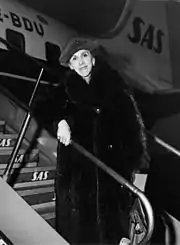 |
| Klaus Rifbjerg | Og andre historier (And Other Stories) | 1964 |  |
| Inger Christensen | Butterfly Valley | 1991 |  |
The 12th item is an Anthology of lyrics consisting of the following 24 works:
| Author | Work | Year | Image |
|---|---|---|---|
| Anonymous folk song | Ebbe Skammelsøn | ||
| Anonymous folk song | Germand Gladensvend | ||
| Thomas Kingo | Hver har sin Skæbne (Sorrig og Glæde...) |  | |
| H. A. Brorson | Den yndigste rose er funden | 1732 | .jpg.webp) |
| Johs. Ewald | Til Siælen. En Ode | 1780 |  |
| Schack von Staffeldt | Indvielsen | 1804 |  |
| Adam Oehlenschläger | Hakon Jarls Død eller Christendommens Indførsel i Norge | 1803 |  |
| N. F. S. Grundtvig | De Levendes Land | First published 1883 |  |
| Christian Winther | Rosa unica | 1849 |  |
| Emil Aarestrup | Paa Sneen | 1838 |  |
| Holger Drachmann | Jeg hører i Natten den vuggende Lyd | 1877 |  |
| Sophus Claussen | Ekbatana | 1896 |  |
| Jeppe Aakjær | Aften | 1912 |  |
| Thøger Larsen | Den danske Sommer | 1914 | |
| Tom Kristensen | Det er Knud, som er død | 1936 | |
| Jens August Schade | Læren om staten | 1928 | _by_Erling_Mandelmann.jpg.webp) |
| Gustaf Munch-Petersen | det underste land | 1933 | |
| Thorkild Bjørnvig | Anubis | 1955 | |
| Ole Sarvig | Regnmaaleren | 1943 | |
| Morten Nielsen | Øjeblik | 1945 | |
| Frank Jæger | Sidenius i Esbjerg | 1959 | |
| Ivan Malinowski | Myggesang | 1958 | |
| Per Højholt | Personen på toppen | 1985 | |
| Henrik Nordbrandt | Violinbyggernes by | 1985 |
Music
The committee for music explained that, taking account of the wide range of Danish music, they gave focus to individual works rather than a composer's oeuvre. They presented two lists: one for what they called score music (classical), the other for popular music, although the two should be considered as a whole. The committee consisted of Per Erik Veng (chair), Jørgen I. Jensen, Torben Bille, Inger Sørensen and Henrik Marstal.[8]
Classical music
| Composer/author | Work | Year | Image |
|---|---|---|---|
| F.L.Æ. Kunzen | Holger Danske | 1789 |  |
| C. E. F. Weyse | Otte Morgensange and Syv Aftensange | 1837 and 1838 |  |
| H. C. Lumbye | Three galops: Telegraph Galop, Champagne Galop and Copenhagen Steam Railway Galop | 1844, 1845 and 1847 |  |
| Niels W. Gade | Elverskud | 1854 |  |
| J. P. E. Hartmann | Vølvens Spaadom | 1872 |  |
| Peter Heise | Drot og marsk | 1878 | 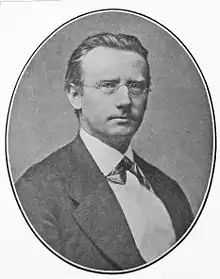 |
| Carl Nielsen | Maskarade | 1906 |  |
| Carl Nielsen | Symphony No. 4: The Inextinguishable | 1916 | |
| Rued Langgaard | Antikrist | 1923 |  |
| Per Nørgård | Symphony No. 3 | 1976 | |
| Pelle Gudmundsen-Holmgreen | Symphony-Antiphony | 1978 | |
The 12th item titled Højskolesange (Folk High School Songs) consists of the following 12 songs:
| Composer/author | Work | Year | Image |
|---|---|---|---|
| C. E. F. Weyse (1826), words: N. F. S. Grundtvig | Den signede dag med fryd vi ser | 1826 | |
| Folk song, words rewritten by Svend Grundtvig | Det var en lørdag aften | 1849 |  |
| Folk song from the Mariager area | En yndig og frydefuld sommertid | Published in A.P. Berggreen's Danske folkesange 1869 | |
| Music: Carl Nielsen, words: Ludvig Holstein | Vi sletternes sønner | Music 1906, words 1903 | |
| Music: Carl Nielsen, words: Jeppe Aakjær | Jens Vejmand | Music 1907, words 1905 | |
| Music: Thomas Laub, words: St.St. Blicher | «Det er hvidt herude» | Melodi 1914, tekst 1838 | |
| Music: Oluf Ring, words: Thøger Larsen | Danmark, nu blunder den lyse nat | Music 1922, words 1914 | |
| Music: Poul Schierbeck, words: Hans Christian Andersen | I Danmark er jeg født | Music 1926, words 1850 | |
| Music: Thorvald Aagaard, words: Laurits Christian Nielsen | Jeg ser de bøgelyse øer | Music 1931, words 1901 | |
| Music: Otto Mortensen, words: Helge Rode | Du gav os de blomster, som lyste imod os | Music 1939, words 1921 | |
| Music: Otto Mortensen, words: Alex Garff | Septembers himmel er så blå | Music and words 1949 | |
| Music: Peter Erasmus Lange-Müller/Shu-Bi-Dua, words: Holger Drachmann | Vi elsker vort land | Music 1887 and 1980, words 1885 |
Popular music
| Composer/author | Work | Year | Image |
|---|---|---|---|
| Kai Normann Andersen | A selection of 12 songs: Musens sang, Den allersidste dans, Pige træd varsomt, Å hvor jeg, ih, hvor jeg, uh hvor jeg vil, I dit korte liv, Man binder os på mund og hånd, Alle går rundt og forelsker sig, Gå ud og gå en tur, Glemmer du, Titte til hinanden, Drømmeland og Gå med i lunden | 1925–1959 | |
| Dansk Guldalderjazz | Dansk Guldalderjazz Vol. 1–4 | 1940–1949 | |
| Savage Rose | The Savage Rose | 1968 | |
| Kim Larsen | Værsgo | 1973 |  |
| Benny Andersen and Povl Dissing | Svantes Viser | 1973 |  |
| Gasolin' | Live sådan | 1976 | |
| Kliché | Supertanker | 1980 | |
| C.V. Jørgensen | Tidens Tern | 1980 | 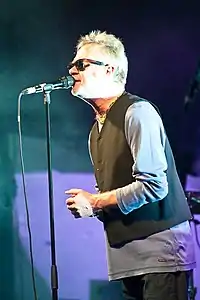 |
| Sebastian | Stjerne til støv | 1981 | .jpg.webp) |
| Palle Mikkelborg with Miles Davis | Aura | 1984/1985 | |
| tv·2 | Nærmest lykkelig | 1988 | |
The 12th item Evergreens is an anthology consisting of the following works:
| Composer/author | Work | Year | Image |
|---|---|---|---|
| Sven Gyldmark/Poeten | Solitudevej – sung by Elga Olga Svendsen. | From Cirkusrevyen 1953 | |
| Sven Gyldmark & Erik Leth | Er du dus med himlens fugle – sung by Poul Reichhardt. | From the film Vagabonderne på Bakkegården 1958 | |
| Vidar Sandbeck & Peter Mynte – single | Heksedans (her kommer mutter med kost og spand) – sung by Raquel Rastenni. | 1960 | |
| Bjarne Hoyer & Ida From | To lys på et bord – sung by Otto Brandenburg | From Dansk Melodi Grand Prix, 1960 | |
| Otto Helge Francker & Sejr Volmer-Sørensen | Dansevise – performed by Grethe Ingmann and Jørgen Ingmann. | From Dansk Melodi Grand Prix, 1963 | |
| Bent Fabricius-Bjerre & Klaus Rifbjerg | Duerne flyver – sung by Cæsar. | From the film Jeg er sgu min egen, 1967 | |
| John Mogensen | Så længe jeg lever – sung by John Mogensen. | Single 1970, also in the album John Mogensen: John, 1973 | |
| Anne Linnet | Smuk og dejlig – performed by Shit & Chanel. | From the album Shit & Chanel, 1975 |  |
| Peter A. G. Nielsen/Gnags | Under Bøgen – performed by Gnags. | From the album Er du hjemme i aften, 1977 |  |
| Shu-bi-dua | Danmark – performed by Shu-bi-dua. | From Shu-bi-dua 78'eren, 1978 | |
| Frans Bak & Per Nielsen | Danse i måneskin – performed by Trine Dyrholm & Moonlighters. | From Dansk Melodi Grand Prix, 1987 | |
| Lars Lilholt | Kald det kærlighed – performed by Lars Lilholt Band. | From Lars Lilholt Band: Portland, 1986 |  |
Performing arts
The committee for performing arts explained that their selection was based on works of unique creativity representing something new for their time while still remaining meaningful today. The committee consisted of Flemming Enevold (chair), Karen-Maria Bille, Jokum Rohde, Sonja Richter and Erik Aschengreen.[9]
| Creator | Work | Year | Image |
|---|---|---|---|
| Ludvig Holberg | Jeppe på Bjerget | 1722 |  |
| Adam Oehlenschläger | Aladdin | 1805 |  |
| August Bournonville and Herman Severin Løvenskiold | La Sylphide | 1836 |  |
| Henri Nathansen | Indenfor Murene (Inside the Walls) | 1912 |  |
| Kaj Munk | Ordet (The Word) | 1932 |  |
| Kjeld Abell | Anna Sophie Hedvig | 1939 | |
| Four revue numbers: | Man binder os på mund og hånd (Liva Weel, 1940), Skolekammerater (Kellerdirk, 1956), Brevet til Bulganin (Osvald Helmuth, 1957), Fingernummeret (Dirch Passer, 1974) | 1940, 1956, 1957 and 1974 | |
| Harald Lander and Knudåge Riisager | Etudes | 1948 | |
| Flemming Flindt and Georges Delerue | Enetime | 1963 | |
| Solvognen | Julemandshæren | 1974 | |
| Sort Sol | Sort Sol live, Carlton og Wurst | 1986–1987 | |
| Jess Ørnsbo | Majonæse | 1988 |
Children's canon
The committee was formed spontaneously as work proceeded in the other areas. It is therefore not an independent selection as suggestions were received from all the other areas.[10]
| Creator | Work | Year | Image |
|---|---|---|---|
| C.Th. Sørensen | Children's building site | 1931 | |
| Gunnar Nyborg-Jensen (ed.) | De små synger | 1948 | |
| Astrid Henning-Jensen | Palle alene i Verden (Film) | 1949 | |
| Carl Barks | The Golden Helmet | 1954 |  |
| Nanna Ditzel | High chair | 1955 | |
| Godtfred Kirk Christiansen | Lego brick | 1958 |  |
| Cecil Bødker | Silas og den sorte hoppe | 1967 | |
| Halfdan Rasmussen & Ib Spang Olsen | Halfdans ABC | 1967 | |
| Katrine Hauch-Fausbøll | Kaj & Andrea | 1971 ff. | |
| Anne Linnet | Go' sønda' morn' | 1980 |  |
| Søren Kragh-Jacobsen | Gummi-Tarzan (Film) | 1981 | |
| Steen Koerner | Nøddeknækkeren | 2003 |
Impact
According to press reports, the canon has had limited impact and has been ineffective in its stated goal of fostering integration between the Danes and the immigrant communities.[11] Berlingske pointed out, nevertheless, that the canon will remain a milestone as a non-socialist government had dared to "simply state that some works are better than others" and assert in that "this country may well be a modern society in a globalised world but that does not mean we have no merit as a nation or no right to national pride."[12] Erik A. Nielsen, a member of the canon's literature committee, is not surprised the literature canon has had such limited effect, faced as it is with a "tsunami of international, strongly commercial cultural interests." He points out that the only reason his students take an interest in Danish culture is that "they have to take exams in it. If they are free to choose culture themselves, they go for films, rock music and a whole lot more that is essentially English or American in origin.[13]
References
- "Denmark/ 4. Current issues in cultural policy development and debate", Compendium: Cultural Policies and Trends in Europe. Retrieved 11 January 2013.
- "Kulturkanon", Den Store Danske. (in Danish) Retrieved 11 January 2013.
- "Om kanon for arkitektur" Archived December 11, 2012, at the Wayback Machine, Kulturkanonen. (in Danish) Retrieved 12 January 2012.
- Hein Heinsen, "Om kanon for billedkunst" Archived December 11, 2012, at the Wayback Machine, Kulturkanonen. (in Danish) Retrieved 12 January 2013.
- "Om kanon for design og kunstværk" Archived December 11, 2012, at the Wayback Machine, Kulturkanonen. (in Danish) Retrieved 12 January 2013.
- "Om kanon for film" Archived December 11, 2012, at the Wayback Machine, Kulturkanonen. (in Danish) Retrieved 12 January 2013.
- "Om kanon for litteratur" Archived December 11, 2012, at the Wayback Machine, Kulturkanon. (in Danish) Retrieved 13 January 2013.
- "Om kanon for musik" Archived December 11, 2012, at the Wayback Machine, Kulturkanonen. (in Danish) Retrieved 13 January 2013.
- "Om kanon for scenekunst" Archived December 11, 2012, at the Wayback Machine, Kulturkanon. (in Danish) Retrieved 13 January 2013.
- Henrik Marstal, "Om kanon for bornekultur" Archived December 11, 2012, at the Wayback Machine, Kulturkanonen. (in Danish) Retrieved 13 January 2013.
- "Denmark’s canon – a damp squib", Presseurop, 27 January 2011. Retrieved 17 January 2013.
- "Regeringens kulturkanon blåstemplede retten til være stolt af det bedste i dansk kultur. Det er dens store og varige fortjeneste". Berlingske, 23 January 2011. (in Danish) Retrieved 17 January 2013.
- Annegerd Lerche Kristiansen and Morten Runge, "Hvad blev der af kulturkanonen?", Danmarks Radio, 16 January 2013. (in Danish) Retrieved 17 January 2013.
External links
- "Kulturkanon", PDF Copy of the Website from 2006 (in Danish)
- Danish Ministry of Culture: Kulturkanonen (English) PDF.